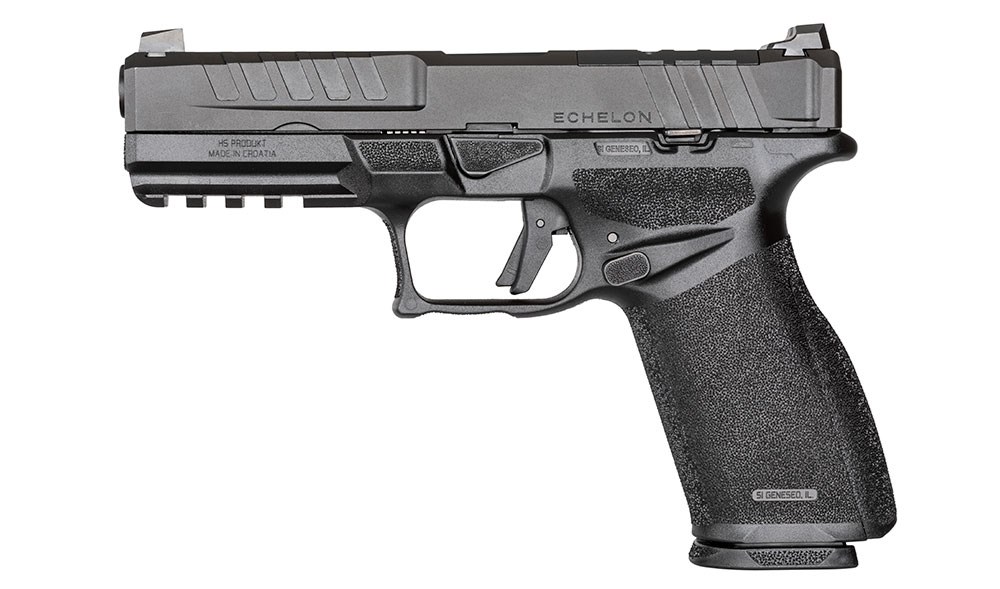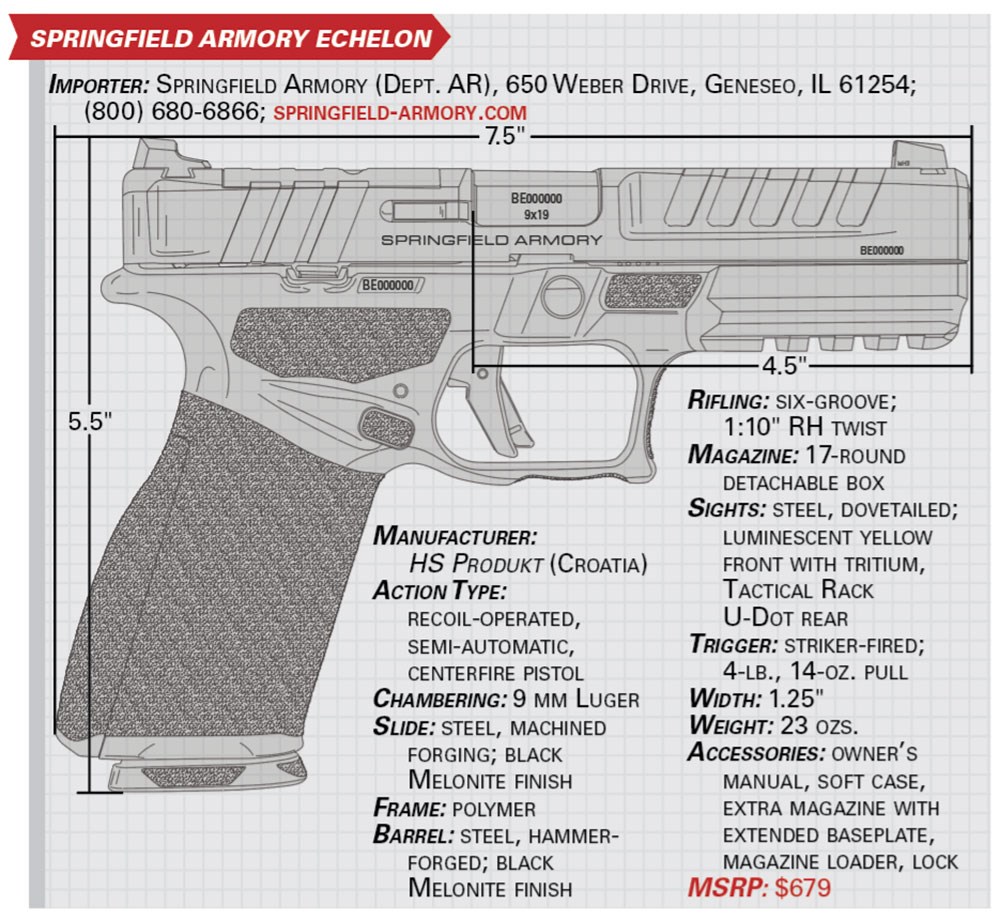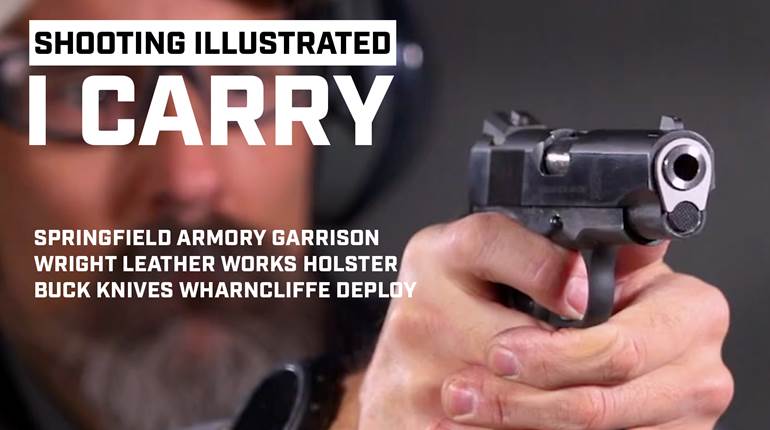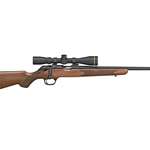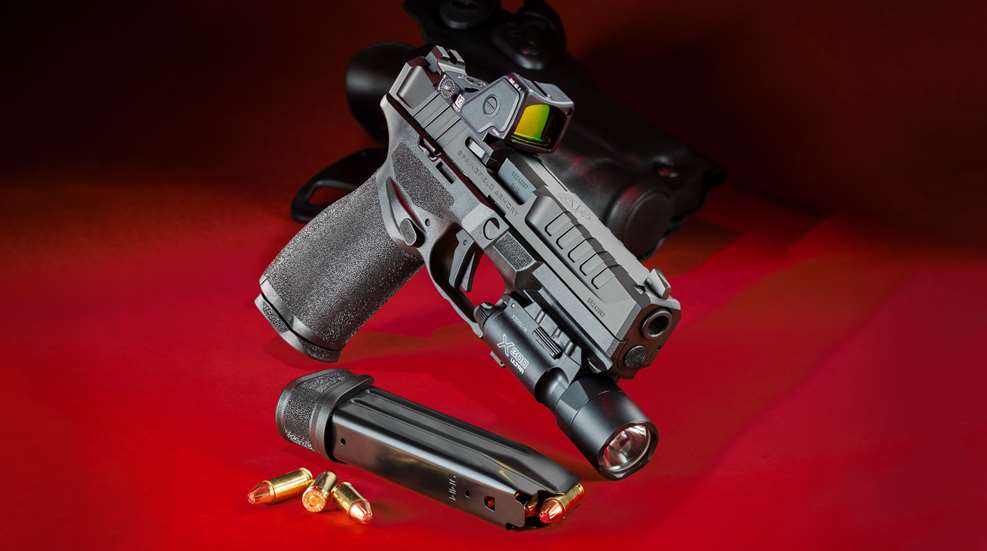
Taking its name from the diagonally oriented military advance formation used at least since the time of the Thebans’ battle with the Spartans at Leuktra in 371 B.C., the all-new Echelon pistol from Springfield Armory is a polymer-frame semi-automatic that holds its own among the world’s best designs. And even though it is wrought from the same decades-long partnership with HS Produkt in Croatia that resulted in Springfield’s highly successful XD-branded antecedents, the Echelon is, technically, quite different. In fact, as its name suggests, the Echelon should be thought of as “out front” of those lines.
Yes, the guns’ shared engineering and manufacturing DNA is readily apparent, but the Echelon leverages its parents’ expertise to chart a new course. According to Steve Kramer, vice president of marketing for Springfield, “We wanted to go back and re-invent the battle handgun—one suitable for combat or duty use.” And that commitment to developing a durable, capacious and adaptable design is evident in the Echelon’s features. The evaluation that follows, however, suggests that Springfield has not only accomplished that mission but that its new offering is also eminently suitable for the dedicated armed citizen.
A Worthy Pedigree
It’s worth noting here that my past experiences with HS Produkt firearms have been positive and that I consider them first-rate in terms of design and quality control—an assessment not out of line with their selection as the provider of service arms for the military forces of Croatia, a NATO member. Further, conversations with Springfield personnel whose reputations as gunsmiths and shooters are highly regarded testify to the fact that the company’s factory in the city of Karlovac is one of the most advanced and vertically integrated in the world, with even such parts as springs and polymer moldings being made in-house. The Echelon, the latest product to emerge from it, evidences that reputation, with excellent fit and finish, no errant tool marks or blemishes, and smoothness in the functioning of its controls.
The gun is being launched in 4.5"- and 5.28"-barreled models, including versions threaded 1/2x28 TPI for suppressor use, with both Tactical Rack U-Dot and three-dot tritium sights and at least one model that ships with a 10-round magazine to restricted states. I tested several samples of the 4.5" standard-barrel model with Tactical U-Dot sights. In any case, regardless of model, the Echelon is, perhaps not surprisingly, a striker-fired, recoil-operated, semi-automatic employing the now-common blade-in-shoe-style trigger safety. It operates on the well-established Browning design principle that keeps the barrel and slide locked together when firing and, momentarily, as they begin to recoil. In this case, an angled cutout in the barrel’s underlug then engages a 0.193"-diameter crosspin in the pistol’s chassis, drawing the barrel’s hood downward and out of locking engagement with the slide’s ejection port.
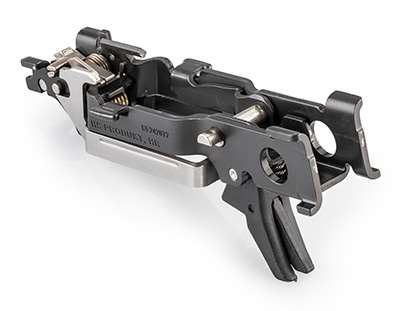
Those following the previous sentence closely likely picked up on the word “chassis,” although Springfield refers to the Echelon’s modular fire-control unit as its Central Operating Group, or COG. It is the most notable difference between the Echelon and all previous HS Produkt pistols and places it into a sparsely populated category. Also noteworthy is that the Echelon’s design dispenses with the grip safety prevalent on most XD models but absent from the benchmark concealed-carry Hellcat. In further departure from earlier designs, the Echelon’s grip angle hews much closer to that of a Glock, at about 18 degrees, rather than the 22 degrees of an M1911.
Along with such major lines as grip angle, the numerous minor contours and surface treatments, including fine stippling, would be cost-prohibitive to machine in metal, so the Echelon’s grip frame is molded from high-strength polymer. And while it serves as a bed for the COG, which is formed from a stainless-steel stamping, the COG itself is the actual serialized receiver. Springfield has leveraged that approach to construction by offering optional small, medium and large frames. According to the company, “Each has slightly tweaked dimensions to offer a range of grip sizes. All three are designed to accept the same interchangeable backstraps. As it stands, the small and medium have the Adaptive Grip Texture, while the large is offered in an ‘aggressive’ grip texture.” Of course, the gun’s construction means that differing shapes and colors of frames could eventually become available from the factory or in the aftermarket and would be free of regulatory paperwork.
A small window molded into the right side of the frame reveals the serial number engraved into the side of the chassis, and “SI GENESEO, IL” is visible through a corresponding window on its opposite side. The chassis mates with recesses in the frame and is secured into position by the takedown lever’s cylindrical, 9/32"-diameter spindle. Formed lips facing outward at the chassis’ front and rear serve as guide rails for the slide, and a separate, bilaterally designed slide stop features tabs that protrude slightly above each side of the frame and are protected by molded-in fencing. They are unobtrusive to the point of being somewhat difficult to engage until just the right placement of the thumb is mastered. In a further acknowledgement of left-handers, the magazine release is also bilateral with stippled, ovular buttons that press inward from either side.
The trigger’s safety blade and shoe, both of which are mostly flat in profile, are made of molded polymer, with the former abutting the frame until the trigger finger depresses it, allowing the trigger proper to move rearward. The gun’s design is such that the striker is fully preloaded upon cocking, with the trigger exhibiting minimal stacking and a reasonably distinct “wall” before it releases. Sections of the grip frame ahead of the chassis on each side and measuring 7/8" long by 5/16" high are molded with a concave shape that acts as a shelf on which to place the support-hand thumb, allowing downward pressure to be applied at the front of the pistol when shooting. That effect is extended on the left side for the majority of shooters by way of the takedown lever, which is also stippled and contoured to match. A four-slot Picatinny rail is incorporated into the Echelon’s dustcover for the mounting of lights or lasers.
Advanced Design
While the COG’s housing, trigger bar and slide lock are made from stampings, the sear, disconnector and other critical components are machined from tool steel and polished. The two test samples’ triggers broke consistently at 4 lbs., 14 ozs., reducing by about 2 ozs. after having been fired hundreds of times. A secondary sear is engineered into the design to act as a drop safety, ensuring resistance to accidental discharges due to rough handling or inadvertent impacts, but it does not directly affect the Echelon’s trigger pull. The one-piece, hammer-forged barrel mates with the slide directly at the front end, and the pair act on a captured, flat-wire recoil spring that rides on a polymer full-length guide rod consisting of a main section and a two-piece bushing at the inner end.
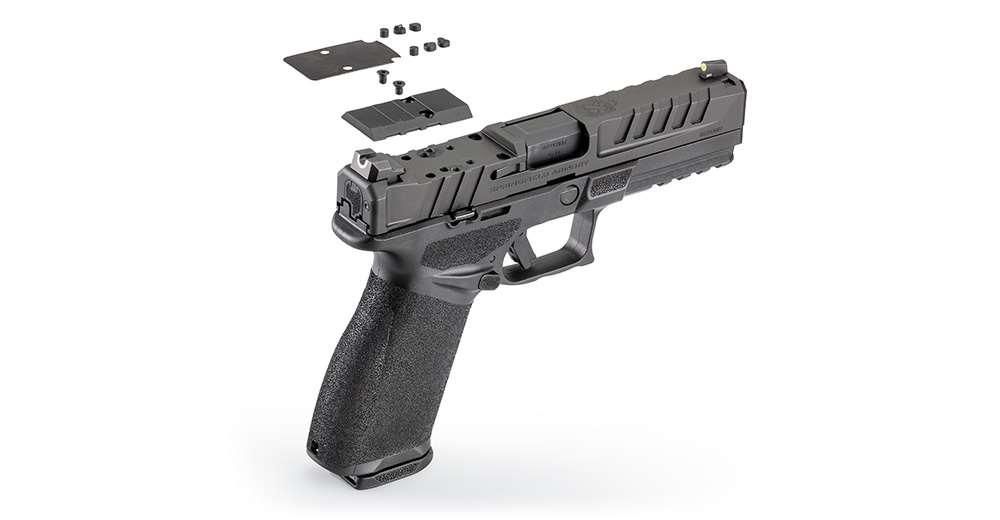
The Echelon’s slide is one of the most intricately sculpted to date, with recessed areas at its front and rear featuring deep, wide grooves to aid purchase during manipulations. Each area tapers inward at its rear, blending through radiuses back out to the slide’s full width for the front set and at a slightly greater dimension for the rear set, resulting in “ears” that make press checks at the front or “slingshot” charging at the rear, respectively, much easier than with many other designs. The pistol’s steel front and rear sights are dovetailed to the slide, with the Tactical Rack U-Dot versions featuring a front unit with a luminescent yellow outer rim around a tritium insert and a rear with the company’s excellent bold, white “U” outlining its notch and the front face allowing for slide racking on a hard edge.
In what may be the Echelon’s most advanced feature, Springfield has incorporated what it refers to as the Variable Interface System (VIS) of optic-mounting plates and pins intended to simplify compatibility with the wide variety of miniature red-dot sights that have flooded the market. A pocket is machined into the slide and accepts one of two adapter plates or one of three sets of four pins—two pair each of cylindrical and eccentric styles. The plates accommodate either ACRO- or Docter-footprint optics, and the pins are labeled for Trijicon RMR (Set 1), Leupold DeltaPoint Pro (Set 2) and Shield (Set 3) interfaces. Springfield explains the pins’ function this way: “As the mounting screws are torqued to spec, the pins exert lateral pressure on the optic’s interior mounting surface to eliminate variance and left/right movement.” The approach is an effective one that affords plenty of recoil-arresting purchase between pistol and optic, but care must be taken not to misplace the pins when mounting or dismounting optics during installations or battery changes.
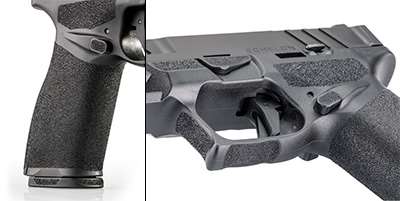
The grip frame’s magazine well is beveled internally and recessed externally on its sides to ease insertion and extraction, respectively, of magazines. Corresponding areas of fine-but-effective stippling are present on the sides of the magazines’ baseplates. The same texture covers the entire grip above and below the raised magazine release/thumbrest area and the release button itself. It is also present on the bottom and front of the trigger guard, on the aforementioned areas behind the accessory rail, the end of the guide rod below the muzzle and the face of the locking plate that holds the striker assembly in the slide. The three included backstraps, which exhibit differing degrees of arc, are easily changed out by inserting a finger into the magazine well and pressing outward on a release tab while simultaneously sliding the installed unit downward off the grip frame. A steel pin molded into each backstrap’s top serves to guide the replacement into position and as a pin punch to detail strip the pistol.
The grip profile is one of the best I’ve ever wrapped my hand around, and I eventually noticed that it bore a distinct resemblance to that of another Springfield model: the SA35. That’s right, the deep recess for the web of the hand and the backstrap’s distinctive outward lower arch are reminiscent of the classic High Power—notable as one of the most comfortable handgun grips of all time. In addition, given my wide palms, I appreciated the Echelon’s generous grip height, which made for a comfortable three-finger hold on the frontstrap and promoted control of the gun in recoil.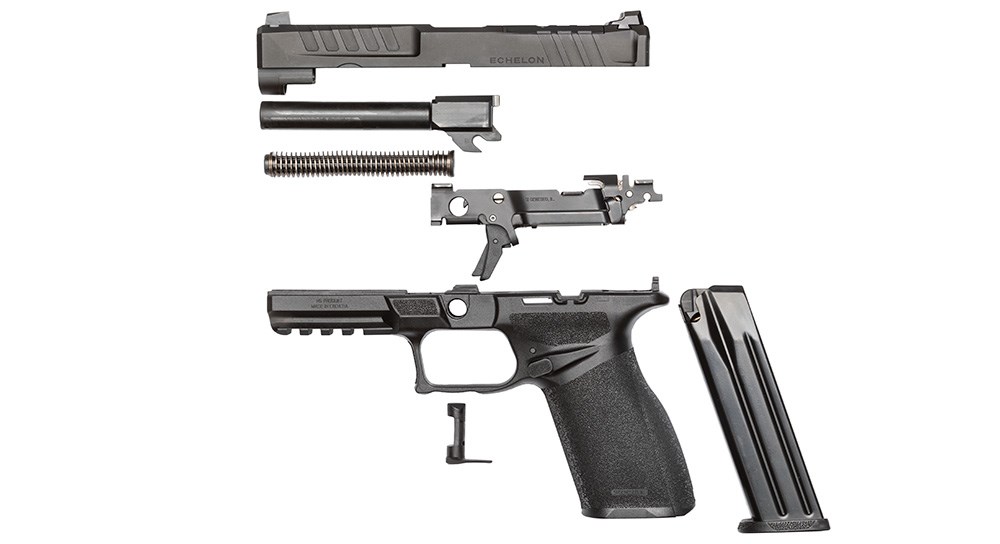
In Perspective
Describing all the aforementioned features might suggest that the Echelon is a large, heavy pistol, but the numbers tell a different story. In fact, by way of comparison to two of Springfield’s other top-tier models, the Hellcat Pro and Prodigy, the Echelon turns in some impressive size, weight and capacity specifications. With a standard 17-round magazine in place and featuring a 4.5" barrel, it measures 7.5" long by 5.5" high by 1.25" wide at the thumbrests, and it weighs 23 ozs. The Hellcat Pro, the company’s XL version of its micro-compact EDC design, with a 3.7" barrel and 15-round magazine in place, is 6.6" long by 4.8" high by 1.25" wide, and it weighs 21 ozs. And the hybrid metal/polymer-frame double-stack M1911-style Prodigy, in the 4.25"-barrel size and with the standard 17-round magazine, is 7.8" long by 5.5" high by 1.4" wide, and it weighs 33 ozs. So, while the feature-laden Echelon is being promoted as a full-on duty pistol, it weighs only 2 ozs. more than the Hellcat Pro and a full 10 ozs. less than the smaller Prodigy. As to size, the Echelon is 0.9" longer and 0.7" taller than the Hellcat Pro but 0.3" shorter than the small Prodigy and no taller. And the Echelon’s width is the same as the Hellcat Pro and 0.15" narrower than the Prodigy. As to capacity, the Echelon offers two more rounds in its standard magazine than the Hellcat Pro and equals the Prodigy.
In yet another comparison, this one to the U.S. Army’s similarly constructed M17 service pistol, the Echelon also comes away leaner and more efficient. The M17, which also holds 17 rounds, is 8.05" long (with a 4.7" barrel) by 5.5" high by 1.4" wide, and it weighs 26.9 ozs., which means Echelon sacrifices only 0.2" of barrel for a 0.55" shorter overall length and that it weighs nearly a quarter-pound less. So, by almost any measure, the Echelon strikes an enviable balance between full-featured duty and tolerably trim carry roles.
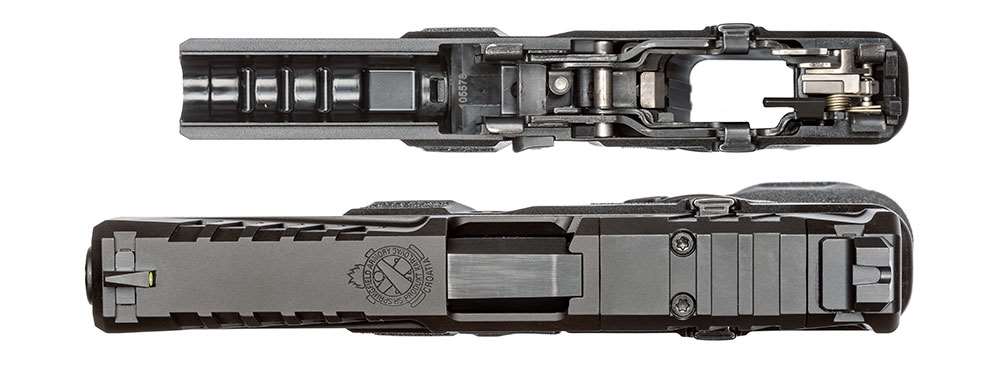
Springfield partnered with several top-tier accessory makers to launch the Echelon, showcasing its capabilities for service by selecting Trijicon’s RMR miniature red-dot, SureFire’s X300 Ultra white light and Safariland’s 6360RDS holster. As might be expected, the Trijicon’s performance was commensurate with the company’s reputation for military-grade quality. As to the SureFire, again, no surprises there, just glaringly bright light in a reasonably compact package easily activated by paddles that straddle each side of the trigger guard. And the Safariland, a level III retention model, is more than capable of shielding the entire rig from a hostile grab attempt. All three accessories functioned properly during several days of familiarity and shooting exercises.
Shooting & Handling
Early on in the testing phase of this evaluation, I was able to get a sample of DeSantis’ excellent Speed Scabbard holster for the Echelon—a style with which I have decades of experience—allowing me to carry the pistol throughout a variety of daily activities. And despite its “full-size” format, the Echelon proved to be surprisingly comfortable and unobtrusive. I practiced drawing, presenting and “firing” a first shot from an empty gun to get a feel for how well it could be deployed, and, despite my ingrained instinct for more traditional grip angles, I was able to become proficient in short order. Then, as I was wrapping up testing, a variety of other holster brands announced the addition of Springfield Echelon options to their product lines.
When it came time to take the Echelon to the range, I endeavored to shoot from as many impromptu positions as possible and from the bench. It ran with no malfunctions and proved to be comfortable and intuitive to deploy. I found the trigger to have far less creep and a crisper let-off than those of several other striker-fired pistols, and the reset was predictable and distinct, occurring only 1/8" from its rearmost position.
I also tasked Managing Editor Christopher Olsen to formally evaluate it with three loads since he is a better shooter and at least as ardent a sleuth of potential deficiencies in new firearm designs. He agreed that the grip frame’s ergonomic cues were well-conceived and -executed and that they made the gun comfortable in the hand. And his function results from several sessions of accuracy testing with a variety of ammunition brands, types and bullet weights was equally flawless. He and I and at least one other staffer noted that, despite its moderate weight, the Echelon seemed to cycle smoothly in the hand, exhibiting minimal muzzle flip, which aided in rapid recovery between shots. It’s likely that such mild-mannered behavior can be credited to the design’s pronounced backstrap undercut and minimal slide height, which result in a favorable bore-axis-to-grip relationship. The Tactical Rack U-Dot rear and luminescent yellow-and-tritium front sights, particularly, make for rapid target acquisition and are set low enough that co-witnessing with a red-dot such as the RMR is assured.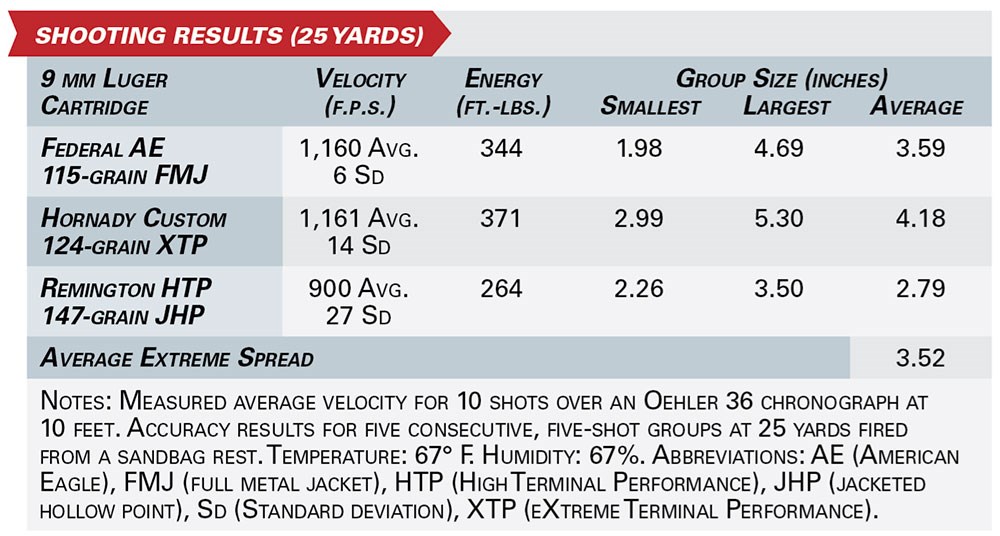
Accuracy testing using the admittedly stringent American Rifleman protocol of five, five-shot groups fired at 25 yards showed the Echelon to be a capable performer, although we noted that the first shot from a fresh magazine typically printed low and left of subsequent shots. Such groups were still respectable overall, with some four-shot clusters measuring as tightly as 1". Subsequent five-shot groups fired from the same magazine averaged closer to 2.5" overall. I could only speculate as to the cause of the errant shot that resulted when the pistol was charged by hand versus during the cycle of operation. There were no visible clues, and wear marks that became evident on the Echelon’s mating metal parts indicated a high degree of consistency in the manufacturing process.
As to the practical matter of feeding the Echelon, its standard 17-round detachable box magazine features a heat-treated stainless-steel body that has a non-reflective, black Melonite-type treatment designed to be slick, easy to clean, highly corrosion-resistant and visually low-key when worn on a belt or vest. It is reasonably easy to fill to capacity, especially when using the included loader. Two magazines come with each pistol along with an extended polymer baseplate and metal floorplate that increase the capacity of one to 20 rounds. Empty magazines fall clear of the frame when the magazine release is pressed from either side, and the button’s size and stippling make for certain engagement.
Finally, when it came time to disassemble the Echelon for cleaning, the process was simple: remove the magazine, which is required in order to rotate the takedown lever, ensure that the gun’s chamber is clear, lock the slide to the rear and then release it to run forward about 7/16" ahead of its typical resting place at which point it can be lifted off the frame. As might be expected from a service or duty arm, there is no need to pull the trigger.
Future Prospects
Given the Echelon’s service-grade DNA, it is not surprising that the company has stated it intends to actively pursue procurement contracts with U.S. law-enforcement agencies and, through its Croatian partner, with military units internationally. Such endeavors are seldom without bureaucratic hurdles and typically meet with uneven success in the short term. But the Echelon’s format efficiency, build quality and performance capabilities, along with a more-than-reasonable price point, suggest that it is likely to find popularity in portions of the civilian market as well in the long term.
Either way, those who choose the Springfield Echelon—whether for duty or personal protection—should find themselves well-equipped with one of the most advanced and capable full-size pistols to date.